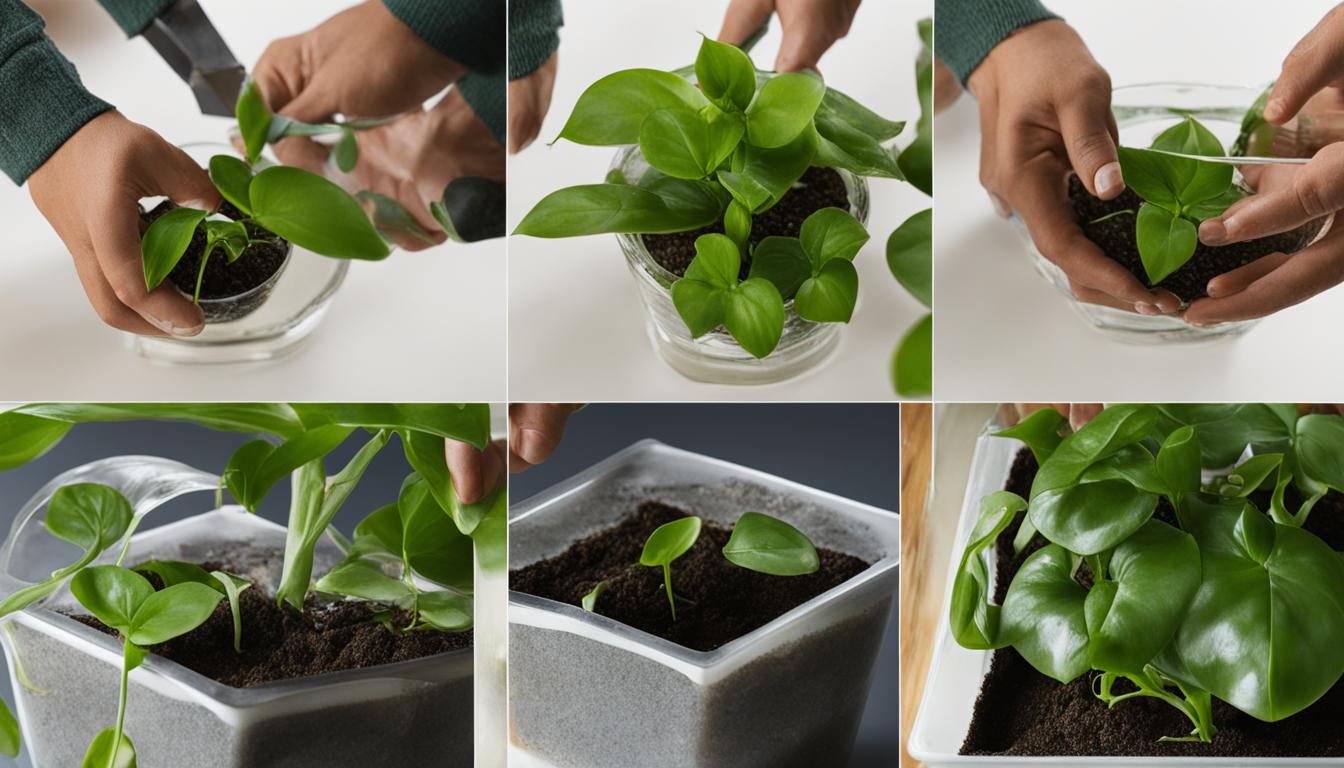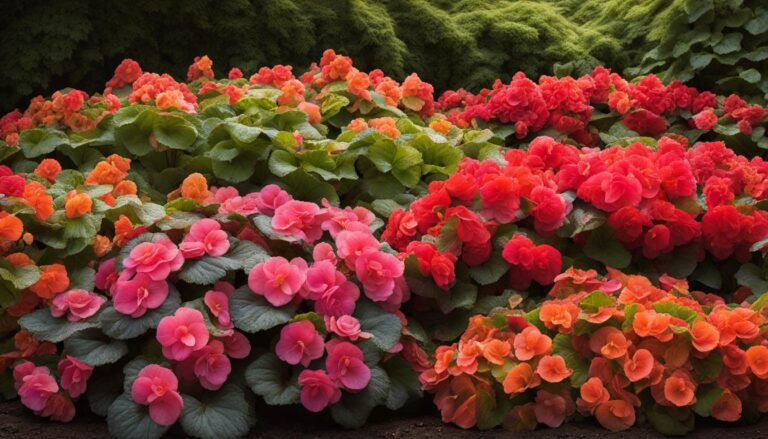
Welcome to my expert guide on growing and caring for Pothos (Epipremnum aureum), a stunning tropical vine known for its trailing vines and heart-shaped green leaves. In this comprehensive guide, I will provide you with essential tips and techniques to ensure the healthy growth of your Pothos plants.
Whether you are a beginner or an experienced plant enthusiast, this guide will equip you with the knowledge to successfully care for different Pothos types, propagate them, and keep them thriving.
Proper fertilizing and propagation techniques are essential for the healthy growth and expansion of Pothos plants. In this section, I will guide you through the steps to ensure your Pothos thrives and multiply.
Fertilizing Pothos
Pothos plants are not heavy feeders, but they can benefit from occasional fertilizing during the growing season. It is recommended to use a balanced houseplant fertilizer once a month from spring to summer. This will provide the necessary nutrients for vigorous foliage growth and maintain the plant’s overall health.
However, it is important to avoid fertilizing your Pothos in winter when the plant goes dormant. During this period, Pothos plants require less nutrients, and fertilizing can lead to salt build-up in the soil. It’s best to resume fertilizing in the spring when the plant starts actively growing again.
Propagation of Pothos
Pothos plants are relatively easy to propagate, making them a popular choice for plant enthusiasts. The most common method of propagation is through stem cuttings.
To propagate your Pothos, select a healthy stem and cut it just below a node, ensuring that the cutting is at least 6 inches long. Remove the lower leaves from the cutting, leaving only a few at the top.
Place the cutting in a jar of water, ensuring that the nodes are submerged. After a few weeks, you will notice roots starting to form. Once the roots are about 1 inch long, transfer the cutting to a pot with well-draining potting soil.
Another propagation method is through layering. Select a long, trailing stem and bury a section of it in the soil, making sure to leave a few nodes above the surface. Roots will develop from the buried section, and once they are established, you can cut the stem from the parent plant and pot it separately.
By following these simple steps, you can successfully fertilize and propagate your Pothos plants, expanding your collection and sharing the beauty of this popular houseplant with others.
Fertilizing Pothos Plants:
- Frequency: Fertilize pothos plants with a balanced, water-soluble fertilizer every 2-3 months. During the growing season (spring and summer), you can increase the frequency to once a month.
- Concentration: Use the fertilizer at half the recommended strength to avoid over-fertilization, which can lead to salt buildup and root damage.
- Type: A balanced fertilizer (e.g., 10-10-10 or 20-20-20) is suitable for pothos plants. These numbers represent the percentage of nitrogen, phosphorus, and potassium, respectively.
- Application: Apply the fertilizer to moist soil to prevent root burn. It’s best to water the plant lightly before fertilizing.
Propagating Pothos Plants:
- Cuttings: The easiest way to propagate pothos is through stem cuttings. Cut a 4-6 inch section of stem just below a node (the point where a leaf attaches to the stem).
- Rooting Medium: Place the cuttings in water or a well-aerated substrate such as perlite mixed with vermiculite or sphagnum moss.
- Root Development: If you’re rooting in water, change the water every few days to keep it fresh. Roots should begin to develop within a few weeks.
- Transplanting: Once the roots are a few inches long, the cuttings can be transplanted into potting soil.
- Environment: Keep the newly potted plants in indirect light and maintain consistent moisture to encourage root growth.
Additional Propagation Methods:
- Division: Pothos can also be propagated by dividing the roots during repotting. Gently separate the roots and plant each section in its own pot.
- Tissue Culture: For large-scale propagation, tissue culture methods are used, but this is generally not practical for home gardeners.
Disease Prevention in Cuttings:
- Sanitation: Use sterilized tools to take cuttings and avoid transmitting diseases.
- Observation: Keep an eye on your cuttings for signs of diseases such as leaf spot or root rot and remove any affected parts immediately.
Remember, while pothos plants are hardy and can tolerate a range of conditions, they will thrive and grow faster with proper care and attention to their needs.
Proper Care and Maintenance of Pothos
In order to ensure the health and vitality of your Pothos plant, there are several important factors to consider. First, it is crucial to maintain the proper temperature in your plant’s environment. Pothos plants thrive in temperatures between 65 and 75 degrees Fahrenheit.
While they can tolerate higher temperatures up to 90 degrees, it is best to avoid exposing them to temperatures below 55 degrees. By providing the ideal temperature range, you can create an optimal growing environment for your Pothos.
| Care Aspect | Details |
|---|---|
| Light | Prefers indirect light; can tolerate intense luminosity but direct sunlight may burn leaves. |
| Temperature | Thrives between 17°C and 30°C (63°F and 86°F). |
| Watering | Water when soil feels dry to the touch, typically once every one to two weeks. |
| Fertilization | Liquid fertilizer can be added in spring. |
| Repotting | Should be replanted every two years or when it becomes too rootbound. |
| Propagation | Can be propagated via cuttings in water or soil, or by dividing the plant. |
| Air Purification | Removes indoor pollutants like formaldehyde, trichloroethene, toluene, xylene, and benzene. |
| Aquarium Use | Can be used in aquariums to absorb nitrates and promote growth. |
| Special Properties | Rarely flowers without artificial hormone supplements; has won the Royal Horticultural Society’s Award of Garden Merit. |
| Toxicity | Toxic to cats, dogs, and mildly toxic to humans due to insoluble raphides and calcium oxalate. Symptoms may include oral irritation, vomiting, and difficulty swallowing. |
Another essential aspect of caring for your Pothos plant is repotting. Repotting should be done once a year to provide fresh soil and allow the plant room for growth. When choosing a new pot, it is important to select one that is only one or two sizes larger than the current pot.
This ensures that the plant is not overwatered and allows for proper drainage. It’s also recommended to check the roots and repot the plant if it becomes pot-bound, as this can restrict the growth of your Pothos.
Lastly, it is important to be aware of the toxicity of Pothos plants. The leaves, stems, and roots contain insoluble calcium oxalate crystals, which can cause irritation if ingested by pets or humans. Extra caution should be taken to keep Pothos plants out of the reach of children and pets.
By being mindful of the potential toxicity, you can ensure the safety of your loved ones and enjoy the beauty of your Pothos without worry.
FAQ
How often should I water my Pothos plant?
Water your Pothos when the top half of the soil dries out. Avoid overwatering, as it can lead to root rot, and underwatering, which can cause the leaves to shrivel. Allow the soil to dry out completely between waterings.
What kind of light does Pothos need?
Pothos plants thrive in bright, indirect light. They can tolerate low-light conditions, but for optimal growth and maintenance of variegated leaves, it is best to provide bright but indirect light. Avoid direct sunlight, as it can scorch the leaves.
How often should I fertilize my Pothos?
Pothos plants do not require heavy feeding. Apply balanced houseplant fertilizer once a month during the spring and summer, but avoid fertilizing during winter when the plant goes dormant.
How do I propagate Pothos?
Pothos can be easily propagated through stem cuttings. Place the cuttings in water until roots form, then transfer them to a pot with potting soil. Layering is another method of propagation, where a stem is bent and buried in soil until roots form.
What temperature does Pothos prefer?
Pothos plants thrive in temperatures between 65 and 75 degrees Fahrenheit. They can tolerate temperatures up to 90 degrees but should not be exposed to temperatures below 55 degrees.
When should I repot my Pothos?
Repot your Pothos once a year to provide fresh soil and room for growth. Choose a pot that is only one or two sizes larger than the current pot to avoid overwatering. Check the roots and repot if the plant becomes pot-bound.
Are Pothos plants toxic?
Yes, Pothos plants are toxic to cats, dogs, and humans. The leaves, stems, and roots contain insoluble calcium oxalate crystals, which can cause irritation if ingested. Keep Pothos plants out of reach of pets and children.







One Comment
Comments are closed.